The Confessing Church was a movement within German Protestantism in Nazi Germany that arose in opposition to government-sponsored efforts to unify all of the Protestant churches into a single pro-Nazi German Evangelical Church.

The Evangelical Church in Germany, also known as the Protestant Church in Germany, is a federation of twenty Lutheran, Reformed, and United Protestant regional Churches in Germany, collectively encompassing the vast majority of the country's Protestants. In 2022, the EKD had a membership of 19,153,000 members, or 22.7% of the German population. It constitutes one of the largest Protestant bodies in the world. Church offices managing the federation are located in Herrenhausen, Hanover, Lower Saxony. Many of its members consider themselves Lutherans.

The Reichskonkordat is a treaty negotiated between the Vatican and the emergent Nazi Germany. It was signed on 20 July 1933 by Cardinal Secretary of State Eugenio Pacelli, who later became Pope Pius XII, on behalf of Pope Pius XI and Vice Chancellor Franz von Papen on behalf of President Paul von Hindenburg and the German government. It was ratified 10 September 1933 and it remains in force to this day. The treaty guarantees the rights of the Catholic Church in Germany. When bishops take office, Article 16 states they are required to take an oath of loyalty to the Governor or President of the German Reich established according to the constitution. The treaty also requires all clergy to abstain from working in and for political parties. Nazi breaches of the agreement began almost as soon as it had been signed and intensified afterwards, leading to protest from the Church, including in the 1937 Mit brennender Sorge encyclical of Pope Pius XI. The Nazis planned to eliminate the Church's influence by restricting its organizations to purely religious activities.
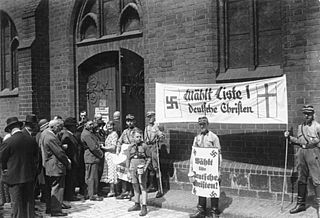
The German Evangelical Church was a successor to the German Protestant Church Confederation from 1933 until 1945. It is also known in English as the Protestant Reich Church and colloquially as the Reich Church.
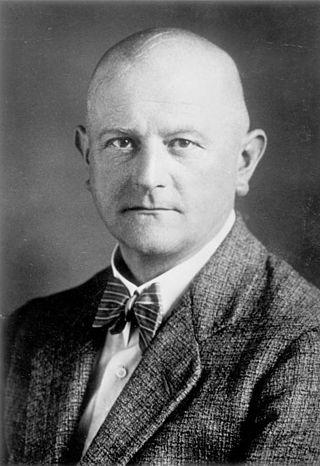
Johan Heinrich Ludwig Müller was a German theologian, a Lutheran pastor, and leading member of the pro-Nazi "German Christians" faith movement. In 1933 he was appointed by the Nazi Party as Reichsbischof of the German Evangelical Church.

The Prussian Union of Churches was a major Protestant church body which emerged in 1817 from a series of decrees by Frederick William III of Prussia that united both Lutheran and Reformed denominations in Prussia. Although not the first of its kind, the Prussian Union was the first to occur in a major German state.

Positive Christianity was a religious movement within Nazi Germany which promoted the belief that the racial purity of the German people should be maintained by mixing racialistic Nazi ideology with either fundamental or significant elements of Nicene Christianity. Adolf Hitler used the term in point 24 of the 1920 Nazi Party Platform, stating: "the Party as such represents the viewpoint of Positive Christianity without binding itself to any particular denomination". The Nazi movement had been hostile to Germany's established churches. The new Nazi idea of Positive Christianity allayed the fears of Germany's Christian majority by implying that the Nazi movement was not anti-Christian. That said, in 1937, Hans Kerrl, the Reich Minister for Church Affairs, explained that "Positive Christianity" was not "dependent upon the Apostle's Creed", nor was it dependent on "faith in Christ as the son of God", upon which Christianity relied; rather, it was represented by the Nazi Party: "The Führer is the herald of a new revelation", he said.
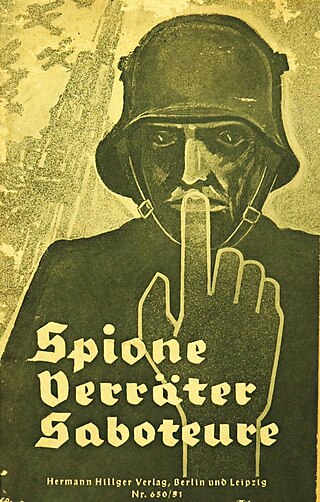
The German resistance to Nazism included unarmed and armed opposition and disobedience to the Nazi regime by various movements, groups and individuals by various means, from attempts to assassinate Adolf Hitler or to overthrow his regime, defection to the enemies of the Third Reich and sabotage against the German Army and the apparatus of repression and attempts to organize armed struggle, to open protests, rescue of persecuted persons, dissidence and "everyday resistance".
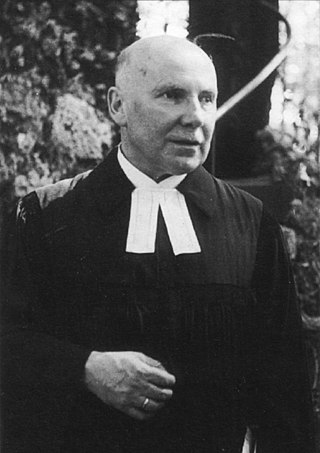
Friedrich "Fritz" von Bodelschwingh, also known as Friedrich von Bodelschwingh the Younger, was a German pastor, theologian and public health advocate. His father was Friedrich von Bodelschwingh the Elder, founder of the v. Bodelschwinghsche Anstalten Bethel charitable foundations.
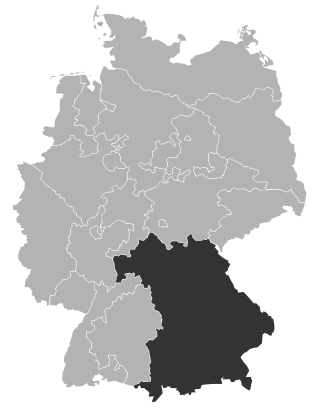
The Evangelical Lutheran Church in Bavaria is a Lutheran member church of the Protestant Church in Germany in the German state of Bavaria.
Kirchenkampf is a German term which pertains to the situation of the Christian churches in Germany during the Nazi period (1933–1945). Sometimes used ambiguously, the term may refer to one or more of the following different "church struggles":
- The internal dispute within German Protestantism between the German Christians and the Confessing Church over control of the Protestant churches;
- The tensions between the Nazi regime and the Protestant church bodies; and
- The tensions between the Nazi regime and the Catholic Church.

Theophil Heinrich Wurm was the son of a pastor and was a leader in the German Protestant Church in the early twentieth century.

Popes Pius XI (1922–1939) and Pius XII (1939–1958) led the Catholic Church during the rise and fall of Nazi Germany. Around a third of Germans were Catholic in the 1930s, most of them lived in Southern Germany; Protestants dominated the north. The Catholic Church in Germany opposed the Nazi Party, and in the 1933 elections, the proportion of Catholics who voted for the Nazi Party was lower than the national average. Nevertheless, the Catholic-aligned Centre Party voted for the Enabling Act of 1933, which gave Adolf Hitler additional domestic powers to suppress political opponents as Chancellor of Germany. President Paul Von Hindenburg continued to serve as Commander and Chief and he also continued to be responsible for the negotiation of international treaties until his death on 2 August 1934.

Formal diplomatic relations between the Holy See and the current Federal Republic of Germany date to the 1951 and the end of the Allied occupation. Historically the Vatican has carried out foreign relations through nuncios, beginning with the Apostolic Nuncio to Cologne and the Apostolic Nuncio to Austria. Following the dissolution of the Holy Roman Empire and the Congress of Vienna, an Apostolic Nuncio to Bavaria replaced that of Cologne and that mission remained in Munich through several governments. From 1920 the Bavarian mission existed alongside the Apostolic Nuncio to Germany in Berlin, with which it was merged in 1934.

Hans Christian Asmussen was a German Evangelical and Lutheran theologian.

Karl Friedrich Stellbrink was a German Lutheran pastor, and one of the Lübeck martyrs, guillotined for opposing the Nazi regime of Adolf Hitler.
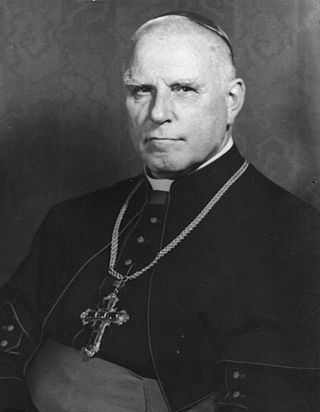
During the Second World War, the Roman Catholic Church protested against Aktion T4, the Nazi involuntary euthanasia programme under which 300,000 disabled people were murdered. The protests formed one of the most significant public acts of Catholic resistance to Nazism undertaken within Germany. The "euthanasia" programme began in 1939, and ultimately resulted in the murder of more than 70,000 people who were deemed senile, mentally handicapped, mentally ill, epileptics, cripples, children with Down's Syndrome, or people with similar afflictions. The murders involved interference in Church welfare institutions, and awareness of the murderous programme became widespread. Church leaders who opposed it – chiefly the Catholic Bishop Clemens August von Galen of Münster and Protestant Bishop Theophil Wurm – were therefore able to rouse widespread public opposition.
The Roman Catholic Church suffered persecution in Nazi Germany. The Nazis claimed jurisdiction over all collective and social activity. Clergy were watched closely, and frequently denounced, arrested and sent to Nazi concentration camps. Welfare institutions were interfered with or transferred to state control. Catholic schools, press, trade unions, political parties and youth leagues were eradicated. Anti-Catholic propaganda and "morality" trials were staged. Monasteries and convents were targeted for expropriation. Prominent Catholic lay leaders were murdered, and thousands of Catholic activists were arrested.
The Crucifix Decrees were part of the Nazi Regime's efforts to secularize public life. For example, crucifixes throughout public places like schools were to be replaced with the Führer's picture. The Crucifix Decrees throughout the years of 1935 to 1941 sparked protests against removing crucifixes from traditional places. Protests notably occurred in Oldenburg in 1936, Frankenholz (Saarland) and Frauenberg in 1937, and in Bavaria in 1941. These incidents prompted Nazi party leaders to back away from crucifix removals in 1941.
The Reich Ministry for Church Affairs also sometimes referred to as the Reich Ministry for Ecclesiastical Affairs, existed in Nazi Germany from 1935 until 1945 under the leadership of Hanns Kerrl and Hermann Muhs and attempted to unify the churches and align them with the goals of National Socialism.














